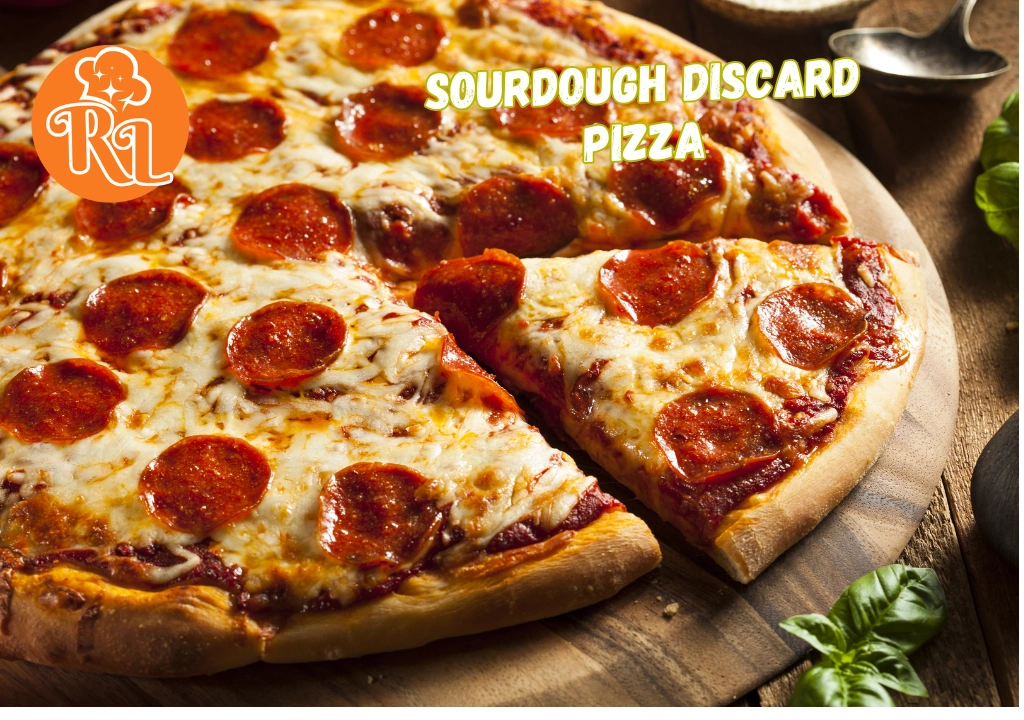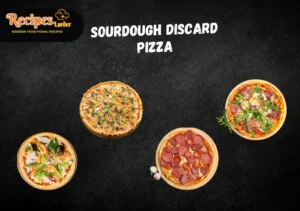Introduction
Sourdough baking has experienced a resurgence in popularity in recent years, particularly during times when people have found themselves spending more time at home. The process of nurturing a sourdough starter, with its bubbling activity and tangy aroma, has become a cherished ritual for many. However, one aspect of sourdough baking that often perplexes and frustrates bakers is the issue of sourdough discard. Every time you feed your sourdough starter, you’re left with a portion of the old starter that often gets thrown away. But what if there were a way to transform this seemingly useless byproduct into something delicious? Enter sourdough discard pizza dough—a culinary revelation that turns waste into a scrumptious meal.
The Problem with Sourdough Discard Pizza
Before diving into the wonders of sourdough discard pizza dough, it’s essential to understand what sourdough discard is and why it poses a challenge to bakers. Sourdough discard is the portion of your sourdough starter that is removed before feeding the remaining starter with fresh flour and water. The removal of this portion helps to maintain the acidity and balance of the starter, ensuring it remains healthy and active. However, this discarded portion is often thrown away, which can feel wasteful, especially for those who bake frequently.

For many, the accumulation of sourdough discard becomes a source of guilt. It’s a waste of flour and water, and the thought of throwing away food, even in its most basic form, is troubling. Additionally, sourdough discard is still a living culture, teeming with natural yeast and bacteria, which makes discarding it feel like a missed opportunity.
The Beauty of Sourdough Discard Pizza Dough
Sourdough discard pizza dough offers an elegant solution to the problem of waste. Instead of throwing away your discard, you can repurpose it into a pizza dough that boasts a unique flavor profile and texture, thanks to the wild yeast and lactic acid bacteria present in the discard. The result is a pizza with a chewy, slightly tangy crust that rivals any traditional pizza dough.
The beauty of sourdough discard pizza dough lies in its simplicity and versatility. The discard acts as a natural leavening agent, meaning you don’t need to rely on commercial yeast to make your dough rise. This not only adds depth of flavor but also allows you to make use of every part of your sourdough starter, minimizing waste.
Crafting the Perfect Sourdough Discard Pizza Dough
Creating sourdough discard pizza dough is a process that requires patience and care, much like traditional sourdough baking. However, it’s a forgiving and flexible method that can be adapted to suit your schedule and preferences.
Step 1: Preparing the Discard
The first step in making sourdough discard pizza dough is to collect your discard. This can be done over a period of time, storing the discard in the refrigerator until you have enough to work with. The discard can be used straight from the fridge or brought to room temperature before incorporating it into your dough. It’s important to note that the older the discard, the more pronounced the tangy flavor will be in your final pizza crust.

Step 2: Mixing the Dough
Once you have your discard ready, it’s time to mix the dough. The process is similar to making any other pizza dough, with the addition of the discard as a key ingredient. The discard is mixed with flour, water, salt, and a bit of olive oil to create a dough that is smooth and elastic. The hydration level of the dough can be adjusted based on the consistency of your discard and your desired crust texture.
Step 3: Fermentation and Proofing
After the dough is mixed, it’s time to let it ferment. Fermentation is where the magic happens, as the natural yeast in the discard begins to work its way through the dough, producing carbon dioxide and alcohol. This process is what gives sourdough its characteristic rise and flavor.
The dough should be allowed to ferment at room temperature until it has doubled in size. Depending on the temperature of your kitchen and the activity of your discard, this can take anywhere from a few hours to overnight. For a more pronounced flavor, you can also refrigerate the dough for a slow, cold fermentation, which will develop the flavors even further.
Step 4: Shaping and Baking
Once the dough has fermented, it’s time to shape it into pizza. The dough should be gently stretched or rolled out to your desired thickness, taking care not to knock out too much of the air that has been incorporated during fermentation. This is what gives the crust its airy, chewy texture.
Baking the pizza is where the final transformation occurs. The dough is placed in a hot oven, where the heat causes the dough to rise and the crust to develop a beautiful, golden-brown color. The tangy flavor of the discard shines through, complementing the toppings of your choice.
Benefits of Sourdough Discard Pizza Dough
Sourdough discard pizza dough offers a myriad of benefits that go beyond just reducing waste. For one, it allows you to enjoy the complex flavors of sourdough without the time commitment of traditional sourdough bread. The tangy, slightly sour notes in the crust add a unique twist to your pizza, elevating it from a simple meal to a gourmet experience.
Additionally, using sourdough discard in your pizza dough can improve the texture of the crust. The natural fermentation process creates a dough that is chewy and airy, with a crisp exterior and a soft, tender interior. This texture is often difficult to achieve with commercial yeast, making sourdough discard pizza dough a cut above the rest.
From a nutritional standpoint, sourdough discard pizza dough also has its advantages. The fermentation process breaks down some of the gluten in the dough, making it easier to digest for those with gluten sensitivities. It also increases the bioavailability of nutrients in the flour, making the pizza not only tastier but also more nutritious.
Variations and Creative Uses
One of the most exciting aspects of sourdough discard pizza dough is its versatility. While the classic Margherita pizza is always a crowd-pleaser, the unique flavor of the sourdough discard dough lends itself well to a variety of toppings and flavor combinations.
For a simple yet delicious option, try a white pizza with ricotta, garlic, and fresh herbs. The tangy crust pairs beautifully with the creamy ricotta and aromatic herbs, creating a harmonious balance of flavors. Alternatively, experiment with bold, unconventional toppings like blue cheese and pear, or prosciutto and arugula. The sourdough discard dough serves as a perfect canvas for your culinary creativity.
Beyond pizza, sourdough discard dough can be used to make a variety of other baked goods. From focaccia to breadsticks, the possibilities are endless. The dough’s versatility means that you can experiment with different shapes, sizes, and flavors, all while making use of your sourdough discard.
Sourdough Discard Pizza Dough: Crafting Deliciousness from Waste
Equipment
- Mixing Bowl: For combining the sourdough discard with other dough ingredients.
- Wooden Spoon or Dough Scraper: Useful for mixing and scraping down the sides of the bowl.
- Measuring Cups and Spoons: To accurately measure flour, water, and other ingredients.
- Bench Scraper: Helps with kneading and dividing the dough.
- Rolling Pin or Hands: For stretching or rolling out the dough to your desired thickness.
- Pizza Stone or Baking Sheet: Provides an even cooking surface for a crispy crust.
- Oven: Essential for baking the pizza at a high temperature.
- Parchment Paper: Optional, for easy transfer of the pizza dough to the oven and for easier cleanup.
- Pizza Cutter or Knife: For slicing the pizza into servings.
- Cooling Rack: To cool the pizza after baking, preventing the crust from getting soggy.
Ingredients
- Sourdough Discard: The portion of sourdough starter that is removed before feeding.
- Flour: Usually all-purpose flour or a combination of all-purpose and whole wheat flour.
- Water: To hydrate the dough and achieve the right consistency.
- Salt: For seasoning and enhancing flavor.
- Olive Oil: Adds richness and helps with dough elasticity.
- Optional Sweetener: A small amount of honey or sugar can be added to balance the flavors, though it's not always necessary.
- Optional Herbs and Spices: Such as garlic powder or dried oregano, for added flavor in the dough.
Instructions
- 1. Prepare the Discard:
- Ensure your sourdough discard is at room temperature. If it's been refrigerated, let it sit out for about 30 minutes before using.
- 2. Mix the Dough:
- In a large mixing bowl, combine the sourdough discard with flour, water, salt, and olive oil.Stir with a wooden spoon or dough scraper until the ingredients are well mixed and a rough dough begins to form.
- 3. Knead the Dough:
- Transfer the dough onto a lightly floured surface.Knead the dough for about 8 to 10 minutes until it becomes smooth and elastic. You can also use a stand mixer with a dough hook if preferred.
- 4. First Rise:
- Place the dough in a lightly oiled bowl, covering it with a damp cloth or plastic wrap.Allow the dough to rise at room temperature for 4 to 6 hours, or until it has doubled in size. For a more developed flavor, you can let it rise in the refrigerator for 12 to 24 hours.
- 5. Preheat the Oven
- Preheat your oven to 475°F to 500°F (245°C to 260°C). If using a pizza stone, place it in the oven to preheat as well.
- 6. Shape the Dough:
- Once the dough has risen, punch it down to release any air bubbles.Transfer it to a floured surface and divide it into two equal portions for medium-sized pizzas or keep it whole for a larger pizza.Roll or stretch the dough into your desired shape and thickness.
- 7. Add Toppings:
- Place the shaped dough onto a pizza peel, baking sheet, or parchment paper. Add your favorite toppings, such as sauce, cheese, vegetables, and meats.
- 8. Bake the Pizza:
- Slide the prepared pizza onto the preheated pizza stone or place the baking sheet in the oven.Bake for 10 to 15 minutes, or until the crust is golden brown and the cheese is melted and bubbly.
- 9. Cool and Serve:
- Remove the pizza from the oven and let it cool on a cooling rack for a few minutes to prevent the crust from becoming soggy.Slice and serve hot.
- Enjoy your delicious pizza made from sourdough discard dough!
Notes
- Discard Freshness: The quality of your sourdough discard affects the dough. Use discard that has been recently fed for the best flavor and activity. Older discard may still work but could result in a tangier flavor and slower rise.
- Flour Types: While all-purpose flour works well, experimenting with a blend of all-purpose and whole wheat flour can add additional flavor and nutrition to the dough. You can also use bread flour for a chewier texture.
- Hydration Levels: Adjust the amount of water based on the consistency of your discard and desired dough texture. If the dough feels too sticky, gradually add more flour; if it’s too dry, add a little more water.
- Fermentation Time: For a more developed flavor, consider a longer, cold fermentation in the refrigerator. This slow rise enhances the dough’s tanginess and overall depth of flavor.
- Kneading: Proper kneading is crucial for a smooth, elastic dough. If using a stand mixer, knead the dough on medium speed until it’s smooth and pulls away from the sides of the bowl.
- Room Temperature Variations: Dough rises faster in warmer environments. If your kitchen is particularly warm, the dough might rise more quickly than the suggested time.
- Preheating: A hot oven and preheated pizza stone (if using) ensure a crispy crust. Allow the pizza stone to heat for at least 30 minutes before baking.
- Toppings: Be mindful of the toppings you use. Heavily loaded pizzas can affect baking time and dough texture. Less is often more for a balanced pizza.
- Storage: Unbaked dough can be refrigerated for up to 3 days or frozen for up to 3 months. If freezing, let it thaw in the refrigerator overnight before using.
- Troubleshooting: If the dough doesn’t rise as expected, check the activity of your discard. Ensure it was fed recently and is bubbly before using. For a faster rise, you can add a small amount of active dry yeast.
Troubleshooting Common Issues
Like any baking endeavor, working with sourdough discard pizza dough can present its challenges. One common issue is a dough that is too sticky or too dry. If your dough is too sticky, try adding a bit more flour, a tablespoon at a time, until it reaches the desired consistency. If it’s too dry, add a bit more water or olive oil, being careful not to overdo it.
Another common challenge is achieving the perfect rise during fermentation. If your dough isn’t rising as expected, it could be due to the activity level of your discard. If the discard is too old or hasn’t been fed recently, it may not have enough active yeast to properly leaven the dough. In this case, try feeding your starter a few times before collecting the discard, or allowing the dough to ferment for a longer period.
Finally, if your pizza crust isn’t as crispy as you’d like, consider baking the pizza on a preheated pizza stone or steel. These tools help to evenly distribute heat, resulting in a crispier crust.
Conclusion
Sourdough discard pizza dough is more than just a solution to the problem of waste—it’s an opportunity to explore new flavors, textures, and techniques in your baking. By repurposing your sourdough discard, you can create a pizza that is not only delicious but also mindful of the resources that go into baking. Whether you’re a seasoned baker or a sourdough novice, this method offers a rewarding and sustainable way to enjoy the art of sourdough baking. So the next time you find yourself with leftover sourdough discard, don’t throw it away. Instead, turn it into something truly special—a pizza that’s as good for the environment as it is for your taste buds.


